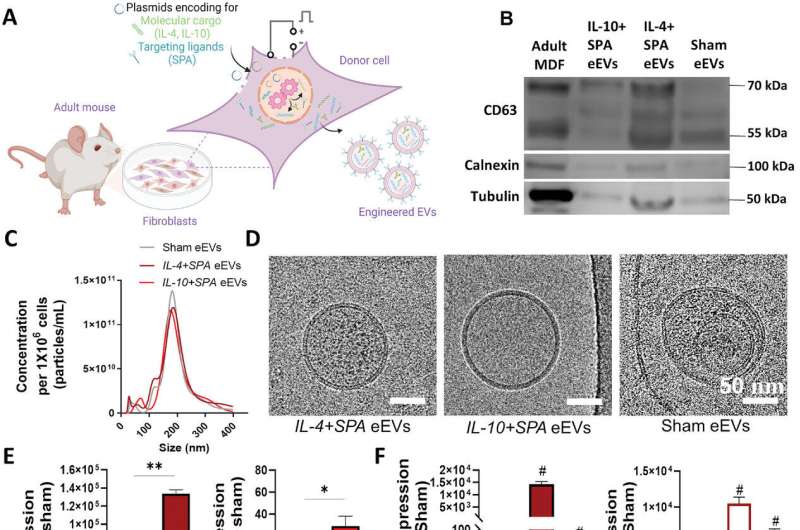
Therapeutic nanocarriers engineered from adult skin cells can curb inflammation and tissue injury in damaged mouse lungs, new research shows, hinting at the promise of a treatment for lungs severely injured by infection or trauma.
Researchers conducted experiments in cell cultures and mice to demonstrate the therapeutic potential of these nanoparticles, which are extracellular vesicles similar to the ones circulating in humans’ bloodstream and biological fluids that carry messages between cells.
The hope is that a drop of solution containing these nanocarriers, delivered to the lungs via the nose, could treat acute respiratory distress syndrome (ARDS), one of the most frequent causes of respiratory failure that leads to putting patients on a ventilator. In ARDS, inflammation spiraling out of control in the lungs so seriously burdens the immune system that immune cells are unable to tend to the initial cause of the damage.
“These extracellular vesicles would be an alternative ARDS therapy that gives a fighting chance to your own immune system,” said senior author Natalia Higuita-Castro, associate professor of biomedical engineering and neurosurgery at The Ohio State University. “The issue with ARDS is that you have a shift in the normal balance that favors inflammation. By introducing the anti-inflammatory agents, you shift that balance to a more level stage so the immune system can resolve the underlying issue.”
The study was published online recently in the journal Advanced Materials.
Starting the engineering process with adult skin cells called dermal fibroblasts is a significant secret to this technology’s success, noted Higuita-Castro, also director of advanced therapeutics and engineering in the College of Medicine Davis Heart and Lung Research Institute.
Many nanocarriers are engineered from stem or progenitor cells that can differentiate into other cell types, but also have mysterious properties that aren’t yet fully understood.
“Using skin cells from adult animals is very important for us because we wanted to demonstrate the feasibility of translating this to clinical settings, where we could have a universal donor cell from adult patients,” Higuita-Castro said. “Dermal fibroblasts are easily available, we can grow them, they’re used in the clinic for grafting and wound healing, and they don’t produce an immune response like that seen with other cell sources.”
To create the vesicles, scientists apply an electrical charge to a donor skin cell to transiently open holes in its membrane, and deliver externally obtained DNA inside. The donor cell converts that genetic information into one of two anti-inflammatory proteins as well as into messenger RNA, molecules that translate instructions for the manufacture of more of those functional proteins.
Those materials are the payload inside these nanocarriers, whose surfaces are tagged with a molecule enabling interaction with specific cells to improve their retention in the lungs. In this study, separate nanocarriers were packed with one of two anti-inflammatory proteins, IL-4 or IL-10, plus mRNA for recipient cells in the lung to process and make more protein.
“The proteins have an immediate effect, and adding mRNA will give a more sustained effect,” said Higuita-Castro, also a core faculty member of Ohio State’s Gene Therapy Institute.
The different proteins were not combined into one vesicle for a reason: “Our vision for clinical applications is to have a mix-and-match platform depending on what the patient needs,” she said. “That way, we could also administer lower doses multiple times, if needed, and re-dosing with these nanocarriers will be OK because they don’t trigger a significant immune response.”
Cell culture experiments suggested these vesicles could be used as a pre-treatment in sick patients at high risk for developing ARDS. Studies in mice showed their potential to help patients who are already severely ill.
After mice were injected with a molecule that triggered high inflammation in the lung, researchers gave them a single drop of liquid loaded with engineered nanocarriers that traveled straight to their injured lungs and got to work. Inflammation was reduced as expected, but repeated experiments in the animals showed the vesicles also lowered damage to lung tissue.
Even more exciting to Higuita-Castro was a finding that cells in the treated lungs secreted substances with additional therapeutic benefits—including antioxidants and more anti-inflammatory molecules.
“Honestly, that was mind-blowing,” she said. “It’s a local treatment because it’s delivered intranasally, and it stays in the lung because we designed it that way, but it has this global effect that is really powerful.”
Finding a safe, effective treatment for ARDS is a significant medical need. The current use of ventilators and steroids comes with lots of side effects, and while the dangerous lung condition used to be relatively rare, case numbers skyrocketed during the COVID-19 pandemic.
“COVID-19 shined a light on the lack of effective therapeutic options for acute lung injury in general,” Higuita-Castro said.
There is more to do with the nanocarriers, including pinning down the precise details of all they can do to repair damaged lungs and testing the therapy in larger animals. But Higuita-Castro is optimistic about the technology’s future.
“These extracellular vesicles are naturally derived nanoparticles, and we think they’re great because nature is the best example we could have—as it has had millions of years to optimize the system,” she said.
More information:
Ana I. Salazar‐Puerta et al, Engineered Extracellular Vesicles Derived from Dermal Fibroblasts Attenuate Inflammation in a Murine Model of Acute Lung Injury, Advanced Materials (2023). DOI: 10.1002/adma.202210579
Journal information:
Advanced Materials
Source: Read Full Article
